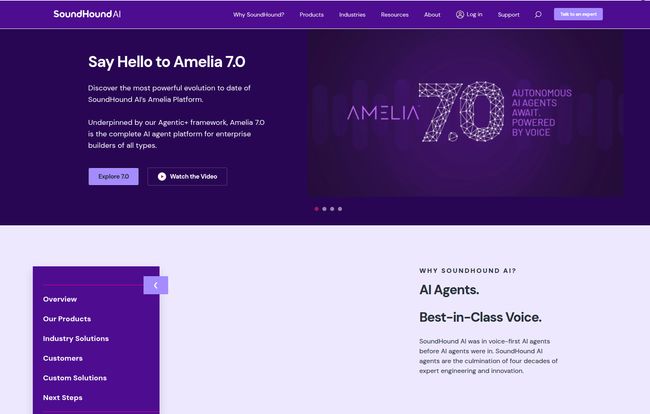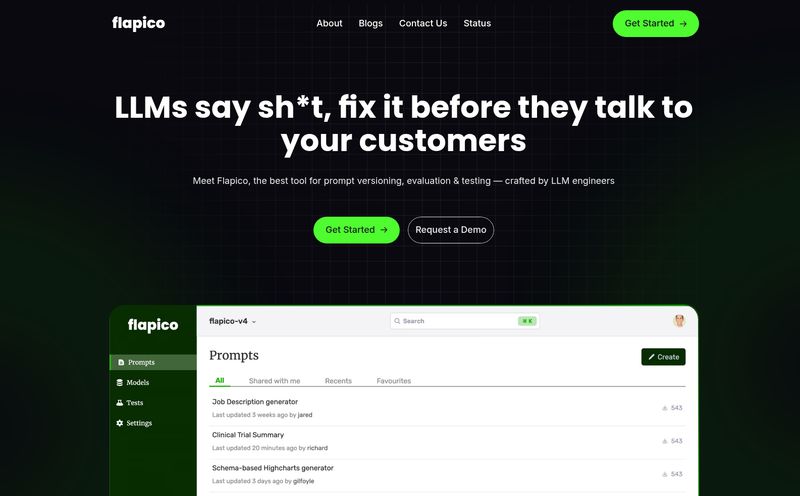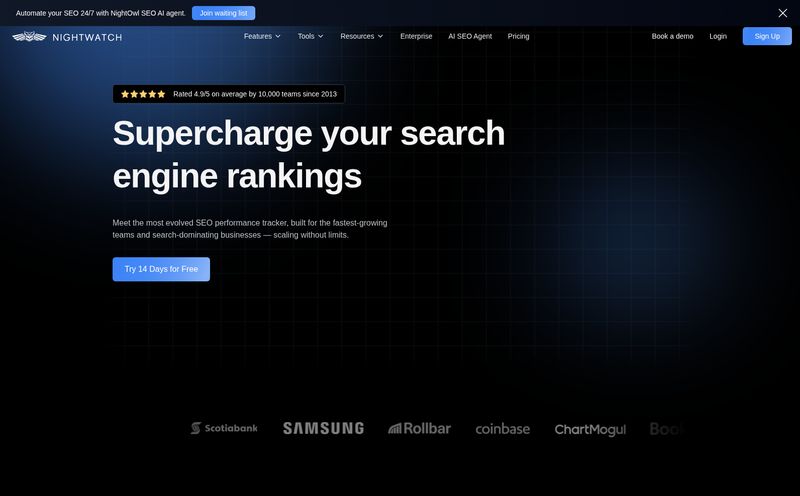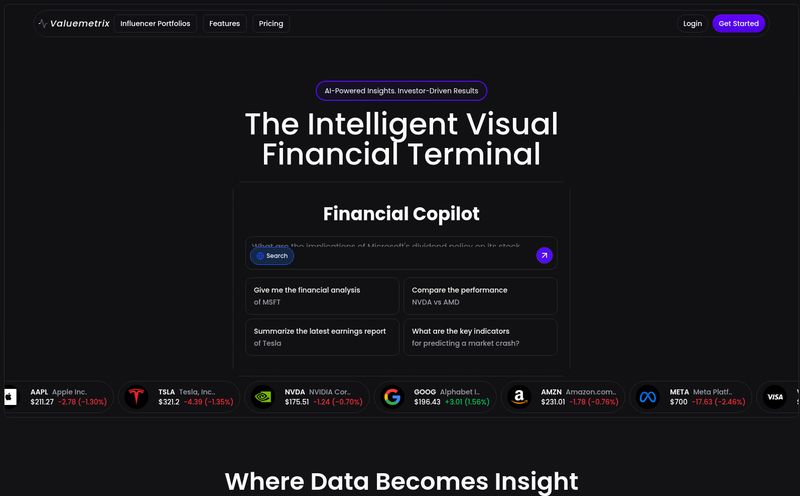I have a love-hate relationship with voice assistants. Seriously. Just this morning, I asked my smart speaker to play some classic rock and it started a podcast about geology. Close, but no cigar. We’ve all been there, right? Shouting corrected commands at a plastic cylinder, feeling just a little bit ridiculous.
It’s easy to get jaded and think all voice AI is this clumsy. But that’s where we, as business and tech people, might be missing the point. The consumer-grade stuff is one thing. Enterprise-level conversational AI? That’s a whole different ball game. And for years, I’ve had my eye on one of the biggest players in that league: SoundHound AI.
You might know the name from the music recognition app that was a rival to Shazam back in the day. But trust me, they've pivoted into something far more substantial. So, let’s get into it. Is this the real deal, or just another tech solution looking for a problem?
So What Exactly is SoundHound AI?
Let's clear this up right away: SoundHound AI is not a smart speaker you buy at Best Buy. Think of it as a powerful, specialized engine and toolkit that lets businesses build their own voice experiences directly into their products and services.
They’re the secret sauce behind the curtain for some massive brands. The landing page is practically a NASCAR hood of logos: Mercedes-Benz, Hyundai, Pandora, Oracle, and even Nvidia. We’re talking about in-car assistants that don’t make you want to pull your hair out, voice-powered ordering systems for bustling restaurants, and even complex applications in healthcare.
Basically, they provide the AI brains for companies that want a unique, branded, and highly functional voice assistant without having to build it from scratch. It’s a platform for creating conversations between a brand and its customers.

Visit SoundHound AI
Digging into the Tech Stack: Houndify, Amelia, and AI Agents
Okay, so how does it all work? It’s not just one thing. It's an ecosystem. I like to break it down into a few key parts.
The Houndify Developer Platform
This is the engine room. The nuts and bolts. Houndify is their platform that gives developers the APIs and tools to integrate advanced voice and conversational intelligence into anything. If you’re a developer, this is where you’d get your hands dirty. What’s really interesting is that, from what I can see on their login page, you can sign up for a free developer account to start tinkering. That’s a pretty confident move and a great way for tech teams to kick the tires before committing.
Amelia 7.0 and the AI Agents
If Houndify is the engine, Amelia is the polished dashboard and the smart driver. The images I’ve seen feature “Amelia 7.0,” which they’re positioning as the next big thing in autonomous AI agents. These aren’t just simple chatbots. They are designed to handle complex, multi-step tasks. Think of an AI agent as a super-powered digital employee who can take a customer’s order, check inventory, process the payment, and confirm the pickup time—all through a natural conversation.
Custom Voice Solutions for Your Brand
This is the part that gets me excited from a branding perspective. It’s not about making your car sound like Alexa or Google. It’s about creating a unique voice that is your brand. Imagine a luxury car brand having a calm, sophisticated voice, while a fast-food chain has an energetic and friendly one. This level of customization is what separates a gimmick from a genuinely integrated brand experience. It's the difference between using a generic stock photo and commissioning a full brand photoshoot. One is functional, the other is memorable.
The Good, The Bad, and The "It Depends"
No platform is perfect, and as an SEO and traffic guy, I’m paid to be skeptical. SoundHound AI has some seriously impressive strengths, but there are things you absolutely need to consider.
On the plus side, the platform is incredibly comprehensive and scalable. Whether you’re a startup or a global automaker, it seems designed to grow with you. The ability to integrate with existing systems is also a massive win; the last thing any CIO wants is another siloed piece of software that doesn’t talk to anything else.
But let’s be real. This isn't a simple WordPress plugin. The first potential drawback is that it likely requires some real technical expertise to implement properly. You’ll need developers who can work with APIs and understand the intricacies of conversational design. You also have to consider the accuracy. While their tech is touted as “best-in-class,” all voice recognition lives on a spectrum of accuracy. What happens when a customer with a thick accent tries to order a complex meal at a drive-thru? Teh potential for frustration is still there, even if it's reduced.
And then there's the big one: privacy. Any time you have a device that's actively listening, customers get nervous. Businesses adopting this technology have to be crystal clear about how voice data is stored, processed, and protected. This isn’t just a technical hurdle; it’s a trust hurdle.
Let's Talk Money: The SoundHound AI Pricing Mystery
So, how much does all this futuristic tech cost? Good question. If you go looking for a pricing page on their site, you’ll come up empty-handed. And honestly, that’s not surprising.
This is standard practice for enterprise-level, highly customized SaaS platforms. There’s no “one size fits all” price. The cost for a global automaker implementing in-dash assistants across millions of vehicles is going to be wildly different from a regional restaurant chain automating 50 drive-thrus. It's like asking “how much does a building cost?” Well, are we talking about a shed or a skyscraper?
The price will depend on the scope of your project, the number of interactions, the level of customization, and the support you need. Your only path forward here is to contact their sales team for a custom quote.
Real-World Use Cases: Where is This Actually Working?
This is where the rubber meets the road. Or, in some cases, literally.
In automotive, the goal is an in-car assistant that actually helps instead of hinders. With partners like Mercedes and Hyundai, SoundHound AI is powering systems that let you control navigation, music, and climate with natural language. No more robotic, specific commands. Just “I’m feeling cold” or “Find me a coffee shop that has a drive-thru.”
In restaurants, this is a game-changer for efficiency. Imagine a drive-thru that never gets an order wrong, can upsell intelligently, and works 24/7 without a break. It's a powerful solution to labor shortages and a direct path to higher throughput.
In healthcare, their messaging about “Whole Person Care” is intriguing. This could be AI agents helping patients book appointments, answering post-op questions, or reminding them to take medication, freeing up human staff for more critical, hands-on care.
My Final Take as an SEO Guy
You might be wondering, “Okay, cool tech, but what does this have to do with SEO and traffic?” Everything. The way people search for information is changing. Voice search is no longer a novelty; it’s a habit. We’re all being trained by our phones and speakers to ask for what we want.
Owning your brand’s voice experience is the next frontier. It’s about being present and useful on the platforms of the future. It’s not just about ranking for keywords on a Google page; it’s about becoming the default, trusted voice your customers turn to. A platform like SoundHound AI is an investment in that future—a way to build a presence in the auditory world, not just the visual one.
Frequently Asked Questions about SoundHound AI
- Is SoundHound AI the same as the music app?
- They share the same parent company and foundational technology, but they are very different products. The SoundHound music app is a consumer product for identifying songs, while SoundHound AI is an enterprise platform for businesses to build custom voice assistants.
- Do I need to be a developer to use SoundHound AI?
- To fully implement and customize a solution using their Houndify platform, yes, you will need development resources. It's a powerful toolset for tech-savvy teams, not a simple plug-and-play solution for the average user.
- How does SoundHound AI handle different languages and accents?
- This is a core part of their technology. Advanced conversational AI platforms invest heavily in training their models on vast datasets to understand a wide variety of languages, dialects, and accents to ensure a smooth user experience.
- Is SoundHound AI better than Alexa or Google Assistant?
- It's not about being better, it’s about being different. Alexa and Google Assistant are broad, consumer-facing ecosystems. SoundHound AI allows a business to create its own independent, branded assistant that lives within its own products, without being tied to Amazon's or Google's ecosystem.
- What are the main privacy concerns with voice AI?
- The primary concerns revolve around data. What audio is being recorded? Where is it stored? Who has access to it? And is it being used for other purposes? Any business implementing a voice solution must have transparent and robust privacy policies.
Conclusion
So, where do I land on SoundHound AI? It’s definitely not a gimmick. It’s a seriously powerful, enterprise-grade platform for brands who are ready to invest in the future of customer interaction. It's not a magic bullet, and it requires real resources and a thoughtful strategy to get right.
But for those willing to take the leap, the potential to increase efficiency, create unforgettable brand experiences, and meet customers in the new, voice-first world is massive. We’re moving beyond the screen, and platforms like this are paving the way. Now, if you’ll excuse me, I’m going to try asking my speaker for 'classic rock' again. Third time's the charm.
Reference and Sources
- SoundHound AI Official Website
- Houndify Developer Platform
- The Rise of Voice Search: A Guide for Modern SEO - Search Engine Journal



